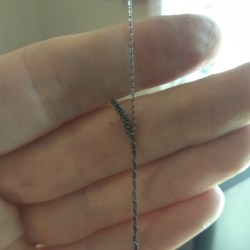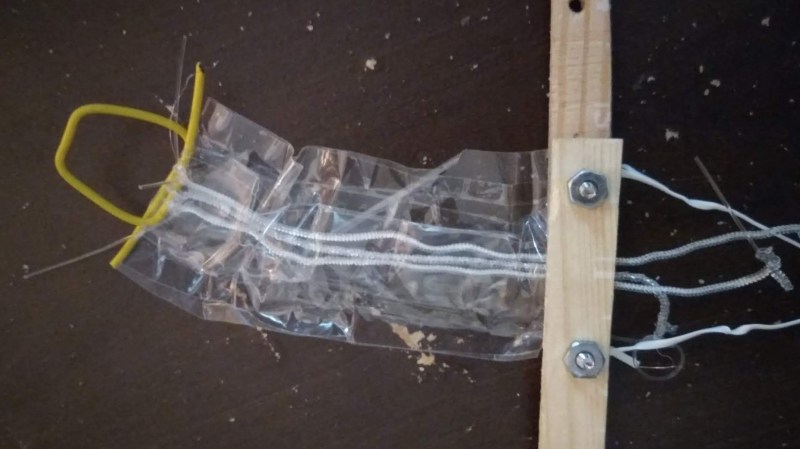Did you know that under the right conditions, nylon can be used as a type of artificial muscle? We certainly didn’t until we came across [Brandon T. Wood]’s Material Linear-Actuator for Robotics entry for the 2018 Hackaday Prize.
 When [Brandon] first learned about Nylon Linear Material Actuators (NLMAs), he became determined to find a repeatable and practical method of making and experimenting with them. This is how it works: hyper-wound coils of nylon, when heated, will contract along their length while expanding in width. Upon cooling, they return to their original shape.
When [Brandon] first learned about Nylon Linear Material Actuators (NLMAs), he became determined to find a repeatable and practical method of making and experimenting with them. This is how it works: hyper-wound coils of nylon, when heated, will contract along their length while expanding in width. Upon cooling, they return to their original shape.
[Brandon] has been busy mainly with the kind of work that is important but not very flashy: finding accessible methods to reliably create strands of artificial nylon muscles cheaply and reliably. His current method uses a jig to wind nylon fishing line until it coils upon itself tightly, then twist a length of nichrome wire around the outside to act as a heater. Using this method, the coils can be electrically controlled. [Brandon] is currently experimenting with creating bundles of individual nylon coils to act all together as one big muscle, because while one wire isn’t particularly strong, a bundle could be quite another story. It’s definitely unusual and is doing a lot of work to turn a known phenomenon into something hackable, which makes it lovely to see in this year’s Hackaday Prize.



















“Did you know that under the right conditions, nylon can be used as a type of artificial muscle?”
Yup! I seem to remember an article by someone who supposedly “discovered” this effect and a lot of people making a big deal that suddenly “muscle wires” were cheap enough for hackers to use in their robotics projects. Then there was a whole lot of “me too” articles where people made use of and worked towards perfecting this technique.
I thought I saw that here at HaD! Though.. it was so long ago… maybe it was just something linked to on Slashdot. For some idea how long ago that was… I’m not sure but I think it was the opening of the RepRap project and the completion of the first Darwin that finally knocked this one down from big news to old news.
corectomundo been on HAD at least twice before : here https://hackaday.com/2014/02/21/researchers-create-synthetic-muscle-100-times-stronger-than-the-real-thing/ and here https://hackaday.com/2016/12/08/nylon-fibre-artificial-muscles-powered-by-lasers/ so while its STILL a nice hack its really nothing new
Perhaps this?
https://hackaday.com/2014/02/21/researchers-create-synthetic-muscle-100-times-stronger-than-the-real-thing/
You’re right, that’s exactly the same! So “we” did know about earlier, oops.
The work [Brandon] is doing on this particular project also isn’t about re-inventing the nylon muscle part, it’s about finding ways to make them electrically (and hopefully reliably) controlled by integrating nichrome wire into the windings to control the heating. It’s certainly economical; hope the performance is there, too.
Search “muscle wire”.
https://hackaday.com/tag/muscle-wire/
I seem to also remember watching a tear-down on an insulin pump that was powered by muscle wire. Was quite impressive that such a small component was able to generate sufficient force.
https://imgur.com/r/EngineeringPorn/jFVUAko
This is done with Nitinol wire, FWIW. I took one of these little pumps apart too, pretty neat.
https://hackaday.com/2016/06/06/artificial-muscles-to-bring-relief-to-robotic-tenseness/
https://hackaday.com/2014/02/21/researchers-create-synthetic-muscle-100-times-stronger-than-the-real-thing/
quickly found 2 times this has been on HaD… you’re memory isn’t lying to you
Muscled out by Darwin?!?! It was long ago but not THAT long ago! http://www.abc.net.au/science/articles/2014/02/21/3948996.htm
You do want this if you want to get reproducable results for multiple strands.
https://youtu.be/iMMGfzYXwAU
Project page:
http://iskanderus.ru/amt-core/
impressive. anyone selling the muscles yet? id love to get a few but dont really want to build the machine.
My son and his team built a machine similar to that for their senior electrical engineering project. It would push out the nylon string and then twist it at a specific rate while heating to automate making muscle wire.
how much retraction do you get in % of relaxed state?
I believe he would come up with a mesh he’d be a lot closer, then there’s the cooling issue. To be effective you need to cool and heat the nylon.
Perhaps multiple strands in a sleeve. Then combine this with the microfluidics project and use a blast of CO2 for cooling. Our robots would exhale CO2 while working out. :)
If I may ask, I have a project I have been planning for a year now, it includes two 5-foot long arms that can extend and retract with movable joints and fingers, the character reference is Roger the Janitor from Little Nightmares, a game from Tarsier Studios. I have needed assistance on material ideas for the arms to look as realistic yet fluid as possible.
I would think fluorocarbon fishing line would be preferable to nylon, with it’s tenancy to hold a coil and higher heat resistance.
I got experience On Electro Wrtiers is An Arn that Send Messages thru telephon Lines with Horizontal n Verical Waves
I tried doing these nylon/fishing line muscles some time back. but i never got them actually working. Winding yes, but working no
Don’t use Nitinol or the fishing line artificial muscles for robotics in exoskeletons. I already did it. Nitinol works but it is extremely power inefficient.
My Nitinol Exoskeltons and Levers Videos:
https://www.youtube.com/watch?v=eL_wJk9FRTo
https://www.youtube.com/watch?v=mJBwq-mVN9Q
https://www.youtube.com/watch?v=avxVoE0uF2I
https://www.youtube.com/watch?v=rIQLhquRX20
https://www.youtube.com/watch?v=fJzRb5lCdEQ
https://www.youtube.com/watch?v=Zkuw2fQzDJ0
https://www.youtube.com/watch?v=d5ATLF5dV-Q
Sorry about no videos on the fishing line artificial muscles. Don’t use if for exoskeletons because it is worse to use than the Nitinol for levers that go back and forth.
By Sean Benson.